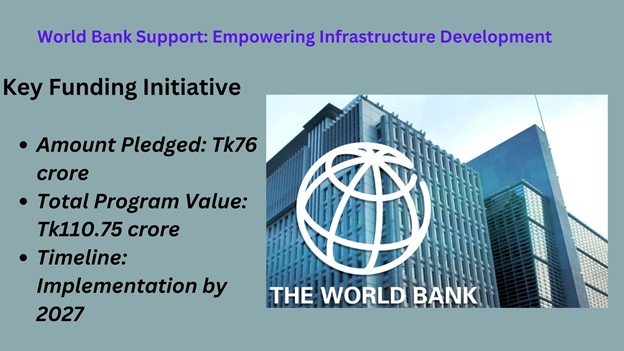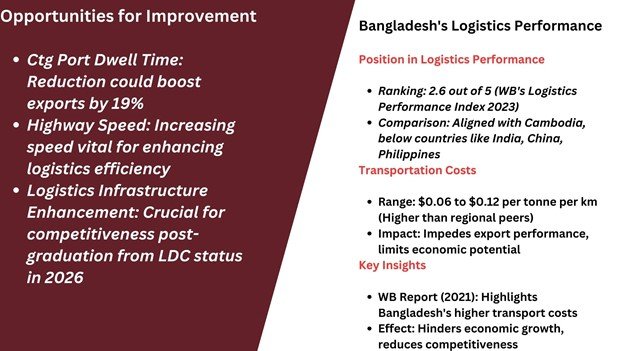A long and unpredictable border transit time, which is observed at most land ports in Bangladesh, is often caused by a mismatch in handling capacity, – the proposal
The Roads and Highways Department (RHD) of Bangladesh has embarked on a strategic initiative aimed at bolstering connectivity between economic zones and land ports through an extensive network of interconnected road corridors. This visionary plan seeks to revolutionize trade logistics, minimize transportation expenses, and fortify Bangladesh’s position as a pivotal hub for sub-regional transport and transshipment activities across South and Southeast Asia.
You Can Also Read: Bangladesh’s Shipbuilding Industry: An Export Powerhouse
One of the primary objectives of the RHD’s strategic plan is to streamline trade logistics by creating a seamless network of roads linking key economic zones and land ports. Currently, transportation costs in Bangladesh rank among the highest in the region, necessitating urgent measures to enhance efficiency and reduce expenses. By optimizing trade routes and infrastructure, the initiative aims to catalyze economic growth and bolster the competitiveness of Bangladeshi industries in the global marketplace.
As the nation continues on its path of development and progress, initiatives like these will play a pivotal role in shaping its future trajectory on the global stage.

Regional Integration
At the heart of this strategic endeavor lies the concept of multimodal connectivity, which envisions the integration of various modes of transportation such as roads, railways, marine terminals, and international borders. By fostering cross-border trade and facilitating the movement of goods and services, Bangladesh aspires to emerge as a sub-regional transport hub with seamless access to neighboring countries. This initiative aligns with broader regional connectivity plans and underscores Bangladesh’s commitment to fostering regional integration and economic cooperation.
World Bank
To materialize this ambitious vision, the RHD has secured support from the World Bank, which has pledged Tk76 crore towards a comprehensive technical assistance program. This program, valued at Tk110.75 crore, aims to identify key projects and conduct feasibility studies essential for the successful implementation of the mega plan by 2027. Through strategic collaboration with international partners, Bangladesh seeks to harness global expertise and resources to drive its infrastructure development agenda forward.
Collaboration
Recognizing the significance of this initiative, the Planning Commission convened an inter-ministerial meeting on 19 March to deliberate on the proposed technical assistance program. Key stakeholders, including representatives from the RHD, the Economic Relations Division (ERD), and the Planning Commission, underscored the importance of selecting the most effective implementation model to ensure the success of the project. This collaborative approach underscores the government’s commitment to fostering synergy and coordination across various ministries and departments.

International Development Partners
In addition to the World Bank, Bangladesh is actively engaging with other international development partners such as the Asian Development Bank (ADB) to garner support for its infrastructure development endeavors. Discussions are underway to explore avenues for increased collaboration and financing from institutions like the ADB, which has shown a keen interest in supporting the development of Bangladesh’s multimodal transport system. By leveraging the expertise and resources of international partners, Bangladesh aims to accelerate the pace of its infrastructure development initiatives.
International Corridors
Currently, inadequate capacity and inefficient handling processes contribute to long delays and unpredictability in border transit times. For instance, at the Petrapole-Benapole border post, which serves as a vital trade route between India and Bangladesh, crossing times can extend up to 138 hours, significantly hampering trade efficiency. By upgrading infrastructure and enhancing capacity at key transit points, Bangladesh aims to streamline cross-border trade and unlock its full economic potential.
The proposal from the Roads and Highways Department (RHD) aims to integrate Bangladesh’s arterial and collector roads into a cohesive surface transit network. This network will be interconnected with existing and planned international corridors, including those under the Bangladesh, Bhutan, India, and Nepal (BBIN) network, the South Asia Subregional Economic Cooperation (Sasec), Asian Highway, and Trans Asian Railway initiatives. These corridors are envisioned not only for domestic transportation but also to serve as trade gateways to neighboring countries.

Logistic Inefficiencies and Costly Transportation
The World Bank’s Logistics Performance Index 2023 positioned Bangladesh alongside Cambodia at 2.6 out of 5, ranking it lower than countries like India, China, and the Philippines. A 2021 report by the World Bank highlighted Bangladesh’s higher transport costs compared to regional peers, ranging from $0.06 to $0.12 per tonne per kilometer, impacting export performance and hindering its full potential.
The report emphasized that reducing Chattogram Port’s dwell time, increasing highway speed, and enhancing logistics infrastructure could boost exports by 19%. The RHD’s proposal recognizes the country’s high logistics costs, crucial for competitiveness post-graduation from LDC status in 2026. Inefficiencies, congestion, and delays in the logistics system affect industries significantly, with logistic expenses ranging from 4.5% to 48% of sales across sectors.
The proposal underscores the importance of developing logistics infrastructure to enhance competitiveness in global trade, attract foreign investment to planned economic zones, and optimize the benefits of mega connectivity projects.
What Trade experts say
“If we build our domestic multimodal transport network, it would not only connect Bangladesh with neighboring countries but could also extend as far as Thailand,” Syed Ershad Ahmed, the country manager of Expeditors, a US-based global logistics company, said, stressing the need to integrate both railway and waterway with highway network to ensure smooth supply of goods to market and keep prices in check.
“The multimodal trade logistics, if implemented as planned, will reduce dependence on seaborne trade with countries within shorter distances and offer Bangladesh an alternative trade route to parts of the world, offering some relief in times of supply chain disruption and soaring ocean freight charges,” said Ershad, also the president of American Chamber (AmCham) of Commerce in Bangladesh.
Vietnam does not offer cash incentives or tax breaks for industries, still, the Asian country excelled in the global export market because of its excellent logistics infrastructures, he pointed out.
In conclusion, the Roads and Highways Department’s strategic plan represents a significant milestone in Bangladesh’s journey towards enhancing connectivity, fostering economic growth, and strengthening regional integration.

